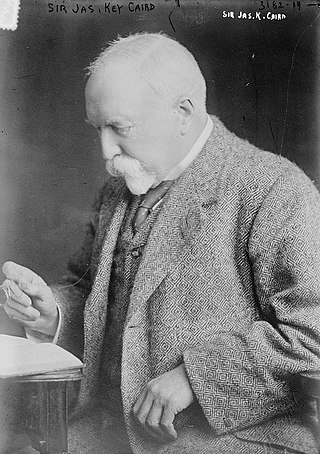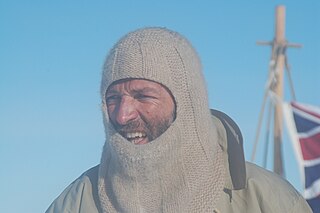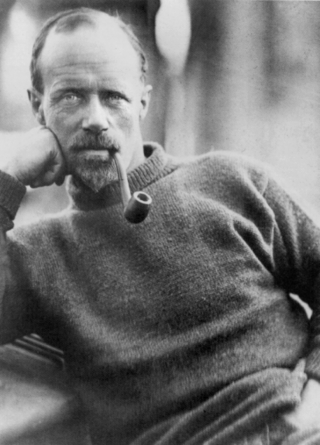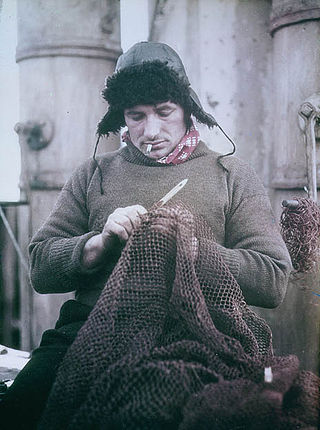Related Research Articles

Sir Ernest Henry Shackleton was an Anglo-Irish Antarctic explorer who led three British expeditions to the Antarctic. He was one of the principal figures of the period known as the Heroic Age of Antarctic Exploration.

Grytviken is a hamlet on South Georgia in the South Atlantic and formerly a whaling station and the largest settlement on the island. It is located at the head of King Edward Cove within the larger Cumberland East Bay, considered the best harbour on the island. The location's name, meaning "pot bay", was coined in 1902 by the Swedish Antarctic Expedition and documented by the surveyor Johan Gunnar Andersson, after the expedition found old English try pots used to render seal oil at the site. Settlement was re-established on 16 November 1904 by Norwegian Antarctic explorer Carl Anton Larsen on the long-used site of former whaling settlements.

Elephant Island is an ice-covered, mountainous island off the coast of Antarctica in the outer reaches of the South Shetland Islands, in the Southern Ocean. The island is situated 245 kilometres north-northeast of the tip of the Antarctic Peninsula, 1,253 kilometres west-southwest of South Georgia, 935 kilometres south of the Falkland Islands, and 885 kilometres southeast of Cape Horn. It is within the Antarctic claims of Argentina, Chile and the United Kingdom.

Sir James Key Caird, 1st Baronet was a Scottish jute baron and mathematician. He was one of Dundee's most successful entrepreneurs, who used the latest technology in his Ashton and Craigie Mills.

The voyage of the James Caird was a journey of 1,300 kilometres (800 mi) from Elephant Island in the South Shetland Islands through the Southern Ocean to South Georgia, undertaken by Sir Ernest Shackleton and five companions to obtain rescue for the main body of the stranded Imperial Trans-Antarctic Expedition of 1914–1917. Many historians regard the voyage of the crew in a 22.5-foot (6.9 m) ship's boat through the "Furious Fifties" as the greatest small-boat journey ever completed.

The Imperial Trans-Antarctic Expedition of 1914–1917 is considered to be the last major expedition of the Heroic Age of Antarctic Exploration. Conceived by Sir Ernest Shackleton, the expedition was an attempt to make the first land crossing of the Antarctic continent. After Roald Amundsen's South Pole expedition in 1911, this crossing remained, in Shackleton's words, the "one great main object of Antarctic journeyings". Shackleton's expedition failed to accomplish this objective but became recognized instead as an epic feat of endurance.

Endurance was the three-masted barquentine in which Sir Ernest Shackleton and a crew of 27 men sailed for the Antarctic on the 1914–1917 Imperial Trans-Antarctic Expedition. The ship, originally named Polaris, was built at Framnæs shipyard and launched in 1912 from Sandefjord in Norway. When one of her commissioners, the Belgian Gerlache, went bankrupt, the remaining one sold the ship for less than the shipyard had charged - but as Lars Christensen was the owner of Framnæs, there was no hardship involved. The ship was bought by Shackleton in January 1914 for the expedition, which would be her first voyage. A year later, she became trapped in pack ice and finally sank in the Weddell Sea off Antarctica on 21 November 1915. All of the crew survived her sinking and were eventually rescued in 1916 after using the ship's boats to travel to Elephant Island and Shackleton, the ship's captain Frank Worsley, and four others made a voyage to seek help.

Frank Arthur Worsley was a New Zealand sailor and explorer who served on Ernest Shackleton's Imperial Trans-Antarctic Expedition of 1914–1916, as captain of Endurance. He also served in the Royal Navy Reserve during the First World War.

Timothy John Jarvis is an English and Australian explorer, climber, author, environmental activist, and documentary filmmaker. He is best known for his numerous Antarctic expeditions, particularly his attempted Antarctic crossing in 1999 and the period recreations of historical treks by Sir Douglas Mawson and Sir Ernest Shackleton.

Arved Fuchs is a German polar explorer and writer.

Endurance: Shackleton's Incredible Voyage, is a 1959 book written by Alfred Lansing, about the failure of the Imperial Trans-Antarctic Expedition led by Sir Ernest Shackleton, in its attempt to cross the Antarctic continent in 1914.

John Robert Francis Wild was an English sailor and explorer. He participated in five expeditions to Antarctica during the Heroic Age of Antarctic Exploration, for which he was awarded the Polar Medal with four bars, one of only two men to be so honoured, the other being Ernest Joyce.

Perce Blackborow (1896–1949) was a Welsh sailor and a stowaway on Ernest Shackleton's ill-fated Imperial Trans-Antarctic Expedition of 1914–1917.

Henry McNish, often referred to as Harry McNish or by the nickname Chippy, was the carpenter on Sir Ernest Shackleton's Imperial Trans-Antarctic Expedition of 1914–1917. He was responsible for much of the work that ensured the crew's survival after their ship, the Endurance, was destroyed when it became trapped in pack ice in the Weddell Sea. He modified the small boat, James Caird, that allowed Shackleton and five men to make a voyage of hundreds of miles to fetch help for the rest of the crew.

King Haakon Bay, or King Haakon Sound, is an inlet on the southern coast of the island of South Georgia. The inlet is approximately 13 km long and 4 km wide. The inlet was named for King Haakon VII of Norway by Carl Anton Larsen, founder of Grytviken. Queen Maud Bay, named for his queen, is nearby. Shackleton Gap, a mountain pass, connects King Haakon Bay to Possession Bay.

John William Vincent was an English seaman and member of Ernest Shackleton's Imperial Trans-Antarctic Expedition. He was one of the five men who accompanied Shackleton on his epic crossing from Elephant Island to South Georgia and was one of only four of the crew of Endurance not to receive the Polar Medal.
Ed Wardle is a Scottish television producer, director, camera operator, and adventurer.

Lionel Greenstreet was the first officer of the Endurance and a member of the Imperial Trans-Antarctic Expedition of 1914–1917, for which he was awarded the Polar Medal. When he died on 13 January 1979, he was the last survivor of the Weddell Sea party within the expedition.

Timothy McCarthy was an Irish leading seaman (LB). He is best known for his service in the Imperial Trans-Antarctic Expedition of 1914–1916, for which he was awarded the Bronze Polar Medal.
Shackleton: Death or Glory is a three-part documentary series following an attempt by adventurer Tim Jarvis to re-create the journey of Ernest Shackleton during his Imperial Trans-Antarctic Expedition of 1916. This two-part journey consisted of an open boat voyage from Elephant Island to South Georgia, then a hike over the mountains of South Georgia to the whaling station at Stromness, where help could be sought.
References
- 1 2 "Paul Larsen (AUS)". Sailing. Retrieved 22 March 2017.
- ↑ "Paul Larsen". Sailrocket. Retrieved 22 March 2017.
- ↑ "Chasing Shackleton: What Paul Larsen Did After Breaking the Sailing Speed Record". Wavetrain. 20 February 2014. Retrieved 22 March 2017.
- ↑ Adam Cort (21 May 2015). "The World's Fastest-sailing Multihulls". Sail. Retrieved 22 March 2017.
- ↑ Jarvis, Tim (2013). Chasing Shackleton: re-creating the world's greatest journey of survival. New York. ISBN 978-0-06-228273-6. OCLC 867571688.
{{cite book}}: CS1 maint: location missing publisher (link)